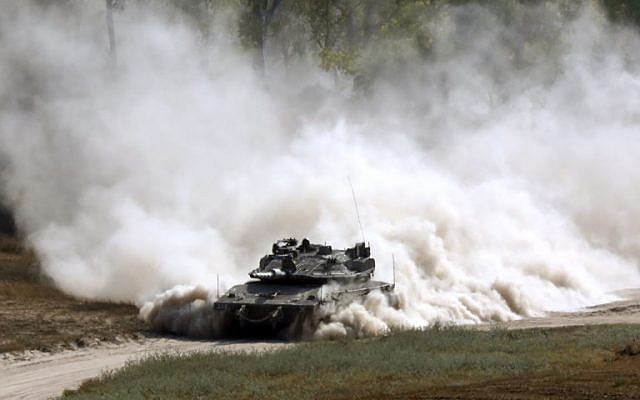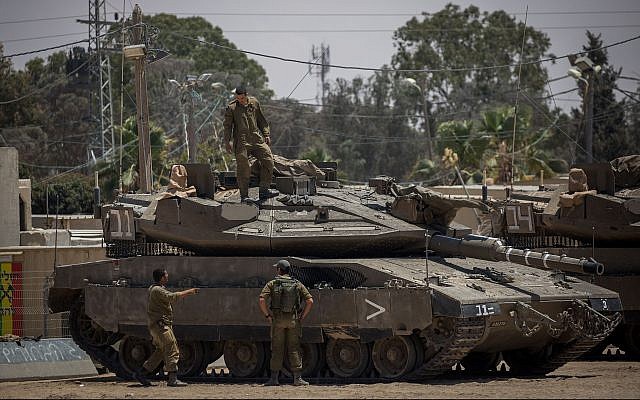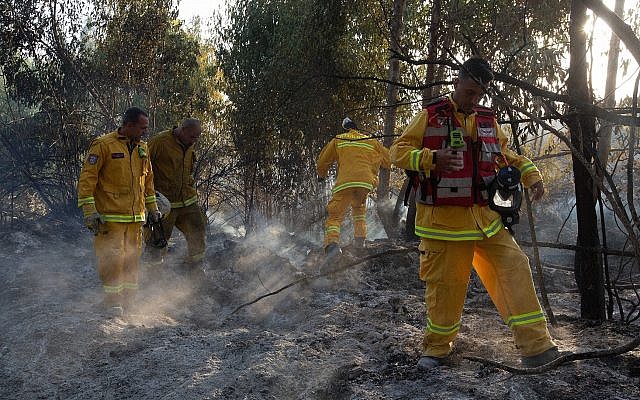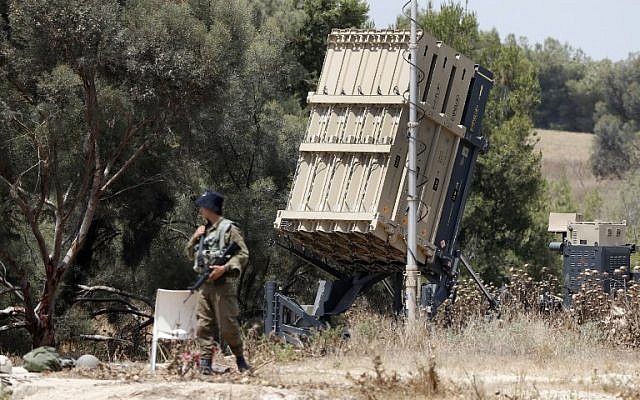

Israeli army drills for Gaza incursion, in apparent warning to Hamas
With tensions high, troops simulate urban warfare in city of Beersheba; commander says IDF can move deep into Gaza quickly, but decisive victory would take time
The Israel Defense Forces on Monday held a large-scale military drill simulating a ground incursion into the Gaza Strip.
The drill in the country’s Negev region, which involved infantry and armored corps, included exercises in urban warfare, with the city of Beersheba serving as a surrogate for Gaza’s cities, Channel 10 news reported.
On Saturday night, a ceasefire of sorts was brokered by Egypt and other international bodies, though Israel was not directly involved in the talks. The violence abated to some degree, but tensions endured and cross-border attacks continued.
Monday’s exercise — which the IDF invited local media to film, and which was detailed on the evening’s main news broadcasts — appeared intended to send a message to Hamas that Israel was prepared to take drastic action, if needed, to bring peace back to the communities in the Gaza periphery, which have also endured weeks of “fire kite” attacks launched from the Hamas-run Gaza Strip.
The IDF’s Gaza Division recruited reserve drivers Monday to help Israel’s fire department and the army deal with blazes in southern Israel caused by the airborne arson attacks.
Also Monday, the military completed deployment of another Iron Dome Missile Defense system in central Israel. The deployment came as part of the army’s preparations for the possibility that Hamas will instruct its operatives to fire long-range rockets at the heart of Israel.
Taking part in the drill, Ohad Najameh, commander of the 401st Armored Brigade, said he believed penetrating deep into Gaza would not take long, but that a decisive victory over Hamas would take some time.
“In order to win, we need to confront the enemy, and we want to confront them on our terms, in our time,” Najameh told Hadashot TV news. “We’ve developed the tools and the exercises so that we will be the stronger side when we meet Hamas.”

Najameh further stated that the IDF was prepared to strike Hamas leadership, and had detailed plans regarding the group’s top officials. “I believe that striking senior officials will deal a significant blow and will affect the battlefield,” he said. “And yes, we will try to strike them.”
He added: “The purpose is decisive action, that when I meet the enemy, I will be able to defeat him and destroy him. We’re preparing surprises on our side, tools the other side is unaware of.”
Lt. Col. Eli Gino, deputy commander of the Givati infanty brigade, added that the commanders and the military as a whole had implemented lessons from the 2014 war in the Strip. “We’ve learned and we’ve improved,” he said.
Over the course of approximately 24 hours Saturday, southern Israel and the Gaza Strip saw one of the largest exchanges of fire since the 2014 Gaza war.
On Friday evening, an IDF soldier was moderately wounded when a Palestinian threw a grenade at him during a riot along the Gaza security fence. In response, shortly after midnight on Friday, the Israeli Air Force conducted airstrikes against Hamas positions in the coastal enclave.
Hamas, which rules Gaza, along with the Iran-backed Palestinian Islamic Jihad and other terrorist groups in the Strip, launched a barrage of mortar shells and rockets at southern Israel.


The attacks from Gaza and Israeli retaliatory strikes continued from 1:30 a.m. on Saturday until shortly after 2 a.m. on Sunday, according to the IDF. In Sderot, three people were moderately injured when a rocket hit a home on Saturday. Hamas’s health ministry said two were killed and over 20 injured in Gaza.
A cessation of hostilities was agreed upon Saturday night, though Israeli officials refused to formally acknowledge it. A senior Israeli defense official would not directly comment on the reported ceasefire, and said: “Facts on the ground will determine our continued response.”
Incendiary kites and balloons continued to be flown into Israel on Sunday and Monday, and Israel has struck in the enclave in response.


Hamas has said it does not see these weapons, which have plagued Israel and sparked numerous fires, as illegitimate or a breach of the agreement. As such, the Gaza-ruling terror group maintains that Israeli strikes in response to these airborne arson attacks amount to violations of the ceasefire.


On Monday members of Israel’s Security Cabinet along with Prime Minister Benjamin Netanyahu toured the IDF’s Home Front Command headquarters and discussed preparations for emergency situations and earthquake scenariosin civilian areas — another growing concern. Netanyahu also visited the rocket-battered Gaza border town of Sderot.
During the tour, the Security Cabinet announced its intention to formulate a 10-year plan that will see NIS 5 billion ($1.38 billion) spent on fortification of infrastructure on the home front, against attacks and earthquakes.


The national initiative will be planned by a joint team headed by the National Security Council, the Defense Ministry, the Finance Ministry, and other government ministries, the Prime Minister’s Office said in a statement.
Source: The Times of Israel





